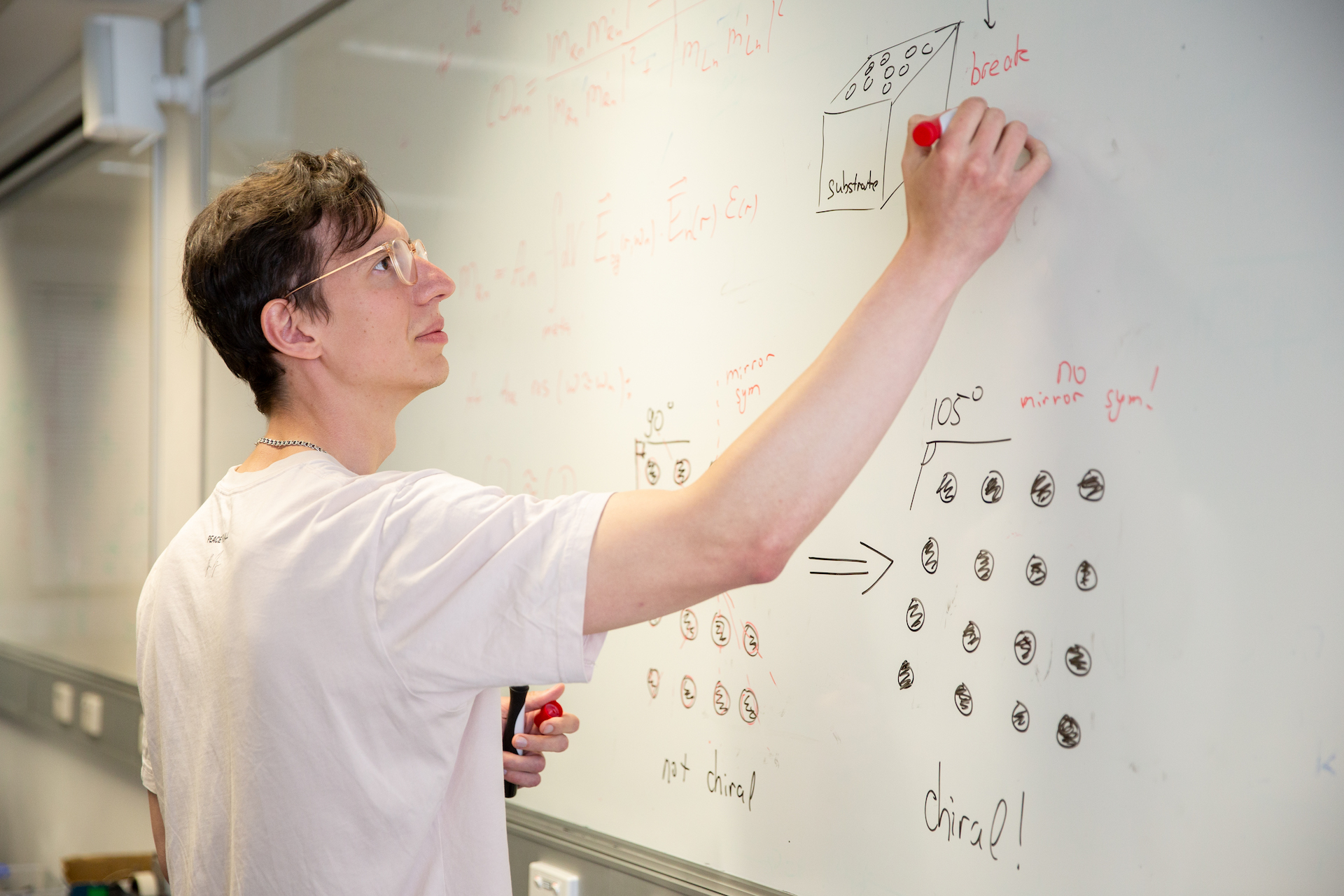Twisted light made simple

A new approach to creating materials that interact selectively with different twists in light, known as chiral responses, greatly simplifies their fabrication, and could pave the way for advances in biosensing, photochemistry, and quantum optics.
A team from the Nonlinear Physics Centre were exploring chiral metasurfaces when they came up with the idea. Metasurfaces are patterned with regular arrays of structures smaller than the wavelength of light; the exact geometry of the structures determines responses to light, that can be dramatically different from naturally occurring materials.
PhD student Ivan Toftul was designing a chiral metasurface, which requires asymmetry to produces the chiral effects. An example effect would be blocking right circularly polarised light while letting through left circularly polarised light.
Chiral metamaterials have been created previously, based on individual asymmetric elements in a regular array. Instead, Mr Toftul began thinking about the overall arrangement of the array, and realised the effect they were looking for could also be created by symmetric elements arranged in an asymmetric way.
“To create individual chiral or, equivalently, mirror asymmetric elements is very challenging, you need advanced fabrication facilities,” he said.
“So we looked at this from a different perspective and realised a simple shift of the whole lattice would break all the in-plane mirror symmetries, and give a chiral response, even if the individual elements were symmetric.”
The research is published in Physical Review Letters.
Chiral properties allow the polarisation of light to be manipulated, which can be used in quantum optics experiments, for example for cryptography or information processing.
Also, many biological molecules are chiral, occurring in left or right-handed configurations that respond to one circular polarisation of light more strongly than the other. This new metasurface’s ability to produce and process polarised light will be a boon in the identification of the different configurations. For example, some drugs are chiral, and only active in one symmetry – the other symmetry may be inactive, or worse still, harmful.
To create an asymmetric lattice, Mr Toftul drew on the crystallography theories of August Bravais, who in the mid 19th century realised that there were only five possible periodic arrangements of two-dimensional lattices. Of these, the most asymmetric is known as monoclinic, and can be created from a square lattice by adding a small offset to each adjacent row.
To test the theory, Mr Toftul sent his design – cylinders of radius 430 nanometers and height 400 nm, set around one micron apart with an offset of 75 degrees – to be manufactured by colleagues in China. Thanks to the simple design they were able to fabricate and return a prototype quickly.
“In the SEM images the metasurface really does not look chiral at first glance, but it actually is,” Mr Toftul said.
“It surprises me that even with cylinders, which are nearly the most symmetric shapes, we can make a metasurface that is as a whole chiral – it’s really non-intuitive.”
Mr Toftul and another PhD student, Pavel Tonkaev, tested the material, and found that there was indeed a significant difference in the response for light with different circular polarisations, with a dichroism of up to 0.2.
For nonlinear effects, the dichroism was even higher: the team tested with third harmonic generation, and found the dichroism to be 0.64.
The metasurface is a fraction of a micron thick, much thinner than conventional materials that produce and interact selectively with left and right circularly polarised light. The team are now testing to see if the new metamaterial can operate effectively as a quarter-wave plate- which would usually be centimetres in size, Mr Toftul said.
“If it works for this purpose, it will be a nice application to miniaturise these devices for use in the lab.”
This article was first published by ANU Research School of Physics.



